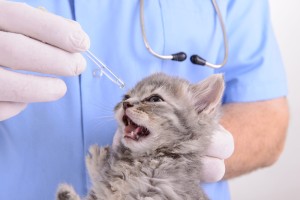8 small cat diseases and ways to treat them in detail
Cats are gentle and loving creatures, but they are at risk of contracting many diseases, especially during the first stage of life, and because their immune system is not fully developed, which causes them to contract small cat diseases, as well as various parasites, and during this article we will show you 8 small cat diseases And ways to treat them in detail.
8 small cat diseases and ways to treat them in detail
- upper respiratory infections
- fleas
- Chronic kidney failure
- Feline leukemia virus
- Infectious peritonitis
- Immunodeficiency virus FIV
- cat cancer
- Hip dysplasia
1- upper respiratory infections
One of the most prominent diseases of kittens, these infections include bronchitis, known as feline herpes virus, and calicivirus, as there are basic vaccines for both these viruses, which usually cause sneezing and nasal secretions, and conjunctivitis also known as pink eye.
The third contagious disease is chlamydia, a bacteria that can be treated with antibiotics such as tetracycline.
How to treat
Cats with nasal or airway congestion may benefit from increased environmental humidification, such as taking them in a steamy bath for 10-15 minutes several times a day. The doctor will also sometimes recommend nasal drops if the nasal discharge is severe.
2- Fleas
One of the most annoying diseases of kittens and one of the most common side effects of fleas is discomfort and itching, and severe infestation can cause fatal anemia in cats.
How to treat
Before spending money on flea treatments, find out if these pests have settled on your cat by:
- Watch for any signs of fleas in their fur.
- Brush the cat's fur with a fine-toothed metal comb from head to tail several times a day. For exfoliating adult fleas and their eggs and combating itching.
- Dip the comb in a mixture of warm to hot water and liquid dish detergent to kill fleas.
- Clean all floors including carpets and hard floors.
- Wash bedding in hot water regularly.
- The necessity of maintaining regular cat vaccinations to prevent insects and fleas.
3- Chronic kidney failure
It is one of the most common cat diseases, and it occurs as a result of your cat eating something poisonous, and its symptoms are:
- brown tongue.
- Bad breath.
- Coat dryness.
- constipation.
- vomiting or diarrhea.
- increased thirst.
- frequent urination.
How to treat
Treatments can range from surgery to remove intravenous fluid blockages to a special diet with certain medications, potassium supplements, antiemetics and vitamins C and B, along with blood pressure lowering medications.
4- Feline leukemia virus
Feline leukemia virus, or FeLV, is highly contagious and can be spread through accidental contacts such as shared food dishes or from the mother cat.
How to treat
There is currently no specific treatment to eliminate the virus from the body, and most cats infected with it eventually die. However, many cats that develop diseases associated with FLV will improve with treatment of symptoms at least temporarily.
5- Infectious peritonitis
This disease appears from diseases of young cats due to genetic predisposition, or in areas with large numbers of cats, as the virus needs to mutate to cause disease, and infection is usually fatal.
How to treat
Until recently, infectious peritonitis was not treatable, but recently identified antiviral medications can be used to treat FIP, and supportive care, including drainage of accumulated fluid and blood transfusion in some cases, is recommended.
6- HIV virus
This virus causes many other infections in cats, and it is usually transmitted through bites, and rarely from the mother cat to her kittens during passage through the birth canal or when kittens swallow contaminated milk.
How to treat
There is no antiviral treatment available specifically to treat FIV, but any secondary illnesses caused by the virus will usually be treated by your vet. Treatments include:
- Medicines to strengthen the immune system.
- Medicines to treat inflammation.
- Medicines to help with any secondary infection.
- Fluid and electrolyte replacement therapy.
- Medications to control parasites.
- Easy diet for cat.
7- cat cancer
Similar to humans, cancer can be localized in a specific area of the cat’s body, as tumors can arise and spread throughout the body, as cells grow rapidly and invade parts of the cat’s body, and genetic and environmental factors are often the main causes of cancer in cats, and symptoms appear as in a:
- swelling;
- Bad breath.
- Weight loss.
- Anorexia.
- diarrhea.
- vomiting.
- appearance of blocks.
How to treat
Adequate cancer treatment can significantly improve a cat's quality of life, and not cause any excessive suffering during treatment. There are three main forms of treatment:
- Chemotherapy and medication.
- Radiation therapy.
- Surgical intervention for excision.
The treatment used for any cat depends on the type of cancer, its location in the body, and the presence of any distant metastases of the tumor.
8- Hip dysplasia
Thought to be hereditary, hip dysplasia is a deformity that can often be corrected with surgery.
How to treat
Most cats respond to non-surgical management with some environmental change, physical therapy, medication, or weight loss. If cats do not improve, two surgical options are available, femoral head and neck excision and hip replacement.






Post a Comment